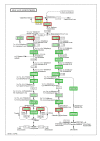Analyzing the regulation of metabolic pathways in human breast cancer
- PMID: 20831783
- PMCID: PMC2945993
- DOI: 10.1186/1755-8794-3-39
Analyzing the regulation of metabolic pathways in human breast cancer
Abstract
Background: Tumor therapy mainly attacks the metabolism to interfere the tumor's anabolism and signaling of proliferative second messengers. However, the metabolic demands of different cancers are very heterogeneous and depend on their origin of tissue, age, gender and other clinical parameters. We investigated tumor specific regulation in the metabolism of breast cancer.
Methods: For this, we mapped gene expression data from microarrays onto the corresponding enzymes and their metabolic reaction network. We used Haar Wavelet transforms on optimally arranged grid representations of metabolic pathways as a pattern recognition method to detect orchestrated regulation of neighboring enzymes in the network. Significant combined expression patterns were used to select metabolic pathways showing shifted regulation of the aggressive tumors.
Results: Besides up-regulation for energy production and nucleotide anabolism, we found an interesting cellular switch in the interplay of biosynthesis of steroids and bile acids. The biosynthesis of steroids was up-regulated for estrogen synthesis which is needed for proliferative signaling in breast cancer. In turn, the decomposition of steroid precursors was blocked by down-regulation of the bile acid pathway.
Conclusion: We applied an intelligent pattern recognition method for analyzing the regulation of metabolism and elucidated substantial regulation of human breast cancer at the interplay of cholesterol biosynthesis and bile acid metabolism pointing to specific breast cancer treatment.
Figures



References
-
- van 't Veer LJ, Dai H, van de Vijver MJ, He YD, Hart AA, Mao M, Peterse HL, van der Kooy K, Marton MJ, Witteveen AT, Schreiber GJ, Kerkhoven RM, Roberts C, Linsley PS, Bernards R, Friend SH. Gene expression profiling predicts clinical outcome of breast cancer. Nature. 2002;415:530–536. doi: 10.1038/415530a. - DOI - PubMed
-
- Van de Vijver MJ, He YD, van't Veer LJ, Dai H, Hart AAM, Voskuil DW, Schreiber GJ, Peterse JL, Roberts C, Marton MJ, Parrish M, Atsma D, Witteveen A, Glas A, Delahaye L, van der Velde T, Bartelink H, Rodenhuis S, Rutgers ET, Friend SH, Bernards R. A Gene-Expression Signature as a Predictor of Survival in Breast Cancer. The New England Journal of Medicine. 2002;347:1999–2009. doi: 10.1056/NEJMoa021967. - DOI - PubMed
Publication types
MeSH terms
Substances
LinkOut - more resources
Full Text Sources
Medical

